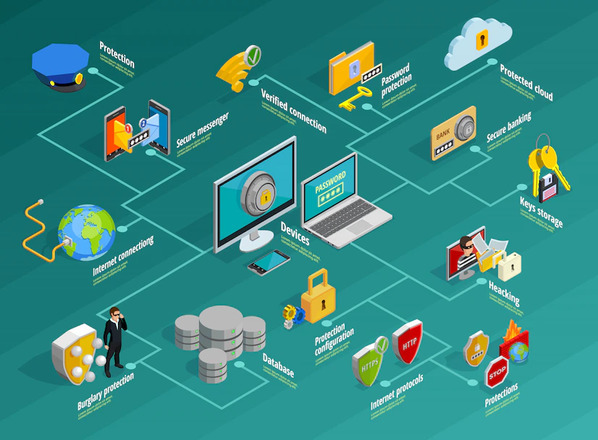All You Need to Know about Web Firewall Application: Types, Deployment, and Benefits

Web Application Firewall Meaning
There is a nonstop game of cat and mouse between cyber criminals and businesses in the IT industry. So it is always decisive to be ahead of the hackers’ thoughts. Firewalls, in particular, have enhanced internet security in a big way.
WAF definition states the following: It is a distinctive firewall that relates specifically to web applications. It is set up in front of web applications where it scrutinizes web-based (HTTP) traffic, spotting and blocking all malicious requests.
It guards web applications against attacks like cross-site scripting (XSS). These attacks are the primary causes of breaches that are the gateway to your valued data. With the correct system in place, you can prevent attacks aiming to exfiltrate data by compromising your systems.
WAF’s Operating Principle
Web application firewall aids in guarding web applications by filtering and watching traffic crossing a web application and the Internet. A WAF is a protocol Layer 7 defense and is not intended to protect against all attacks. Instead, this attack prevention method is part of a suite of tools that create all-inclusive protection against various attacks.
When one deploys a WAF, a protective shield appears between the application and the Internet. The tool uses a reverse proxy to defend the server from exposure. It makes clients go through it before reaching the server by shielding customer identity using an intermediary or a proxy.
A WAF functions through a set of instructions often called policies. These policies protect susceptibilities in the application by filtering out malicious traffic. The value comes partly from the promptness and simplicity with which one can apply policy alteration. It also allows for faster reactions to varying attack routes. For example, during a DDoS attack, one can quickly implement rate regulation by modifying policies.
Model Deployment Process
You can implement a web firewall application in three different ways. You choose your way depending on where your applications are positioned, the duties needed, desired management routine, the architectural suppleness, and the performance level you require. Do you want to self-manage or require outsourced administration? Do you need a cloud-based solution or a sit-on-premises one? Your deployment interest will help define which one is right for you.
WAFs can operate as network appliances, plugins, or cloud services. They examine each packet and investigate application layer (Layer 7) logic conferring to the rules to filter out suspicious or dangerous traffic. Choosing the best model for your business can be a tricky process but don’t worry! Here, we provide instructions on the detailed deployment of different models.

Hardware-Based Web Application Firewall
A hardware-based WAF is set out through a hardware device fitted locally within the local area network in the proximity of the servers. The main advantage of this model is that it has fast speeds and a high-performance routine. Besides, it has low latency due to its close location to the servers. This, in its turn, significantly reduces the distance for the data packets to travel. The major downside, though, is its costliness.
Software-Based WAF
A software-based WAF is set up in a virtual machine (VM) instead of a hardware piece of equipment. However, both models function similarly, featuring analogous components. The only difference is that software-based users need a hypervisor to run the virtual machine.
The main advantage of using the software-based WAF is flexibility.
First, you can apply it with an on-premises system.
Second, you can also deploy the virtual machine in the cloud, linking it to cloud-based web servers.
Besides, a software-based option is noticeably cheaper than a hardware one.
However, keep in mind that since it is run on a virtual machine, you’ll deal with a higher latency during the checking and filtering process. It makes this model less speedy than other types.
Cloud-Based Web Application Firewall
This model comes in the form of Software As a Service. The components are in the cloud; thus, installing anything locally or on virtual machines is not required. Cloud-based WAF can be accomplished through various subscriptions, including the following:
- 1. Cloud-based + Fully Managed as a Service — if you require the fastest and hassle-free way to get your WAF before your applications, then this is the perfect cloud-based service for you.
- 2. Cloud-based + Self-Managed — it is self-managed and thus offers more flexibility and secure portability. It brings about efficiency while still regulating traffic control and security policy sets.
- 3. Cloud-based + Auto-Provisioned is easily provisioned, making deploying security policies pretty easy. It is the simplest and most cost-efficient way to start your security journey in the cloud.
Cloud-based WAF eliminates the need for users to physically install any software leaving the only task to enroll in a subscription plan. In addition, the service provider offers all the optimization and updates, hence eliminating the occurrence of a user having to manage the system alone. However, since it is a service provider running, it is entirely handled by the provider. To clients, it means only little room for customization.
Types of Web Application Firewalls
Beyond the deployment models, there are various web app firewalls, each with a specified task for your system. That said, the different types of WAF include the following:
- 1. Blocklist WAF
A blocklist specifically closes off traffic from particular IP addresses or networks known to be malicious. This can help prevent attacks from unknown sources and protect the website or web application from harm. Additionally, to provide a more comprehensive level of protection, you can use blocklists with other features like rulesets and behavioral analysis.
- 2. Whitelist or Allowlist
In this method, all IP addresses are denied access by default. Only requests from known sources are granted, meaning that a whitelist only provides safe IPs. While this can be a suitable method, remember that it’s quite resource-intensive. Besides, it might lead to unintentional blockage of good traffic.
- 3. Hybrid Web Application Firewall
The hybrid contains both blocklist and allowlist model elements. It incorporates the list of blacklisted traffic while still having the safe list.
- 4. Signature-Based Detection
It searches for specific, known, malicious patterns and blocks. Though many firewalls use it, others consider it an intrusion detection tool.
Benefits of Web Application Firewall

With the devolution of organizational security protocols, understanding a better security strategy helps protect your business from malicious threats. Some benefits that organizations reap from using this system include the following:
- Application Profiling
Analyze a software application’s performance to identify areas for improvement. This can help developers optimize the application for better performance and scalability. It can also help identify potential security vulnerabilities. For example, with WAF, you get detailed information about the traffic flowing to and from the system. This can include information about the type and volume of traffic as well as the application’s response time and error rates. By analyzing this information, developers can identify and improve its performance.
- Customization
WAF operations define and instantly apply organizations’ or WEB application-specific security guidelines to application traffic. This permits customization of WAF behavior without the jeopardy of blocking genuine traffic.
- AI/ML Pattern Analysis
The best software uses artificial intelligence algorithms and machine learning to accomplish behavioral scrutiny. They monitor traffic, characterize baselines for specific varieties, and seize irregularities. Hence, the tool remains useful even when the application endures attacks that do not match the known malicious patterns.
- API Abuse Monitoring
API abuse monitoring is a technique used to detect and prevent unauthorized or malicious use of an application programming interface (API). An API abuse occurs when an attacker uses an API to gain access to sensitive data or disrupt the operation of an application. You can use a web application firewall to protect against API abuse by monitoring and analyzing incoming traffic to an API and blocking requests considered abusive. You can achieve this by identifying abusive requests, such as checking for known attack patterns or examining the content of the request for suspicious characteristics.
- Availability Attack Protection
It can help protect against availability attacks by monitoring and filtering incoming traffic to a website and blocking requests that are part of a distributed denial-of-service (DDoS) attack. Besides, it can prevent DDoS attacks by analyzing incoming traffic and identifying patterns indicative of an attack, blocking these requests, and allowing legitimate traffic to continue to access the website.
- Protection Against Cross-Site Scripting
Cross-site scripting (XSS) attacks are a type of security vulnerability that allows an attacker to inject malicious code into a website. This malicious code can then spill over to other users who visit the website, potentially allowing the attacker to steal their sensitive information or take control of the user’s computer.
WAF can help protect against XSS attacks by monitoring and filtering incoming website traffic and blocking requests containing malicious code. This can help prevent attackers from injecting harmful code into a website and protect users who visit the website from being affected by the attack.
- Protection Against Web Exploits
Setting out a cloud WAF is an excellent way to protect applications against various threats, such as security misconfigurations, cross-site scripting, and SQL-injection attacks.
Importance of a Web Application Firewall

With more complex cyber-attacks looming daily, businesses and organizations should adapt and put themselves in the best position to protect themselves and their clients from unprecedented malicious acts.
Companies in finance and other web-based platforms face a persistent threat of fraud and data theft, which may leave them prone to compromised data and client distrust. WAFs are necessary security protocols that many online organizations – such as mobile app developers, social media providers, and digital bankers – should use. Besides, you can use this technology to protect your customer’s most sensitive data like credit card details.
Besides, it allows professionals to leverage a web firewall application to monitor a possible attack in progress by receiving alerts when there is a violation of the pre-determined guidelines. Using a WAF can aid you in meeting agreement necessities such as the PCI DSS (Payment Card Industry Data Security Standard) – a must for any organization dealing with cardholder data and requires the installation of a firewall.
Additionally, it is vital to combine a WAF with other security protocols. Those include intrusion detection systems (IDS), intrusion prevention systems (IPS), and traditional firewalls. All of them are necessary to achieve a defense-in-depth security model. A WAF is thus a vital component of an organization’s comprehensive security model.
Who Uses a WAF
A Web Firewall Application provides a way to control access to web applications. Therefore, most companies would profit from using a WAF. One is strongly encouraged to use it for start-ups/re-launch, in particular, and when a present customer/established company desires to make variations to their web application.
In a start-up phase, you might need to learn what a ‘normal’ traffic pattern looks like. However, taking advantage of WAF allows you to filter legitimate traffic. If in the future you want to rewrite your applications, the software can learn traffic patterns similarly. This lets customers concentrate on their basic service and do not necessitate putting too much energy into figuring out the build mechanism for the network.
Many of those who presently use a Web Application Firewall are key banks and financial institutions, where the protection of their services against hackers is primal. However, in reality, anyone with a web application who believes it is worth protecting should use a WAF. This ensures high availability and counteracts the risk of data loss and corruption.
FAQ
A WAF guards web applications against a selection of application layer attacks. Keep in mind that attacks on apps are the top cause of breaches.
The main difference is that a WAF is a specialized security tool explicitly designed to protect web apps. At the same time, a firewall is a more general-purpose security system meant to protect networks.
WAFs complement network firewalls and provide additional protection, although they do not replace the original firewall layer.
Yes, it should have a firewall to protect it from various security threats.
It is a security tool that protects web applications from various types of cyber attacks, such as SQL injection, cross-site scripting, and unauthorized access.
Conclusion
Typically, you can use versatile tools to protect sites or databases. Those include proxy servers, Next Generation Firewalls (NGFW), and stateful inspections. WAFs, in particular, guarantee security by seizing and examining every HTTP request. Illegal traffic can be verified using several methods. Those include fingerprinting, input device scrutiny, and CAPTCHA tests. If they seem illegitimate, they can be blocked.
WAFs are pre-loaded with security rules that can detect and block many known attack patterns. Most enterprises have invested in them to manage their APIs and protect their apps. However, more than this tool solely is needed to achieve API security. The WAF and other technologies help offer safe and secure surroundings for digital business requests. This enables IT teams to better guard APIs and critical assets from cyber-attacks. It also helps create and maintain an effective API security program altogether.
